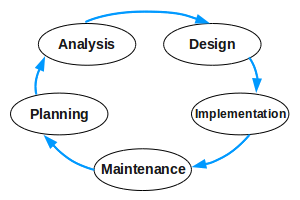Table of Contents
When the system approach is applied to the development of the system solutions, a multi-step process or cycle emerges. This is frequently called the system development cycle, or system development Life Cycle.
System Development Life Cycle (SDLC) process applies to system development projects ensuring that all functional and user requirements and agency strategic goals and objectives are met.
System Development Life Cycle provides a structural and standardized process for all phase’s system development efforts. These phases track the development of the system through several development stages from
- feasibility analysis, system planning, and concept development
- to acquisition and requirement definition
- design
- development
- integration and testing
- development and acceptance
- though development and production
- System retirement
However, there are several other major activities are involved in a complete development Cycle are as follows
- Investigate/Planning
- Analyse
- Design
- Implement
- Maintain

Investigate or planning
- Outline the problem and scope of present system.
- Review the new system and decide its objectives.
- Verify project feasibility and produce the project schedule.
- During this section, threats, constraints, integration and security of system are also considered.
- A feasibility report for the complete project is created on the end of this phase.
Analysis and Specification
- Gather, analyze, and validate the data.
- Define the requirements and prototypes for new system.
- Evaluate the alternatives and prioritize the requirements.
- Examine the data needs of end-user and enhances the system goal.
- A software Requirement Specification (SRS) document, which specifies the software, hardware, useful, and network necessities of the system is ready on the stop of this phase.
System Design
- Includes the design of application, network, databases, user interfaces, and system interfaces.
- Transform the SRS file into logical structure, which contains specific and entire set of specifications that may be implemented in a programming language.
- Create a contingency, training, preservation, and operation plan.
- Review the proposed design. ensure that the final design have to meet the requirements stated in SRS document.
- Finally, prepare a design record which will be used during next phases.
Implementation
- Implement the design into source code thru coding.
- Combine all the modules together into training environment that detects errors and defects.
- A test file which contains errors is prepared through test plan that includes test related tasks such as test case generation, testing criteria, and resource allocation for testing.
- Integrate the information system into its environment and install the new system.
Maintenance/support
- Include all of the activities which includes phone support or physical on-site assist for users this is required once the system is installing.
- Implement the changes that software might undergo over a time period, or implement any new requirements after the software is deployed on the customer area.
- It also includes handling the residual errors and resolve any issues that may exist within the system even after the testing phase.
- Maintenance and support may be needed for a longer time for large systems and for a brief time for smaller systems.